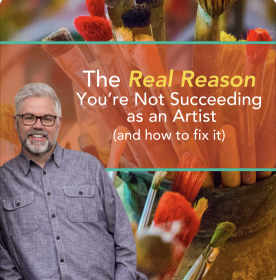
I make my living as a full-time vocational artist, speaker, author and leader of an artist mentoring group. Because of that dynamic, I get asked one question a lot in almost every situation I find myself. It goes something like this: “I’m a (fill in the blank) artist and I want to start selling my work (or start making money, start thriving, etc) but I just can’t seem to choose a direction. I like everything. What should I do?”
This question and ones like it encapsulate the dilemma in which many emerging artists find themselves; that is how to go from the proverbial here to there. How do I move from being a hobbyist to a more serious part-time or full-time artist. It’s a big frustration for many that keeps them up at night, causes confusion and even anxiety about their purpose in life. However, it doesn’t have to be that way.
I want to compare and contrast the way hobbyists approach their art practice vs the way professional artists approach theirs. This is not to say that all hobbyists are immature or that all professionals have ‘made it’… However, in my experience in working with artists and from my own journey, these attributes are true for many. Hopefully this comparison will give you some insight into where you are now and how to start moving in the direction you want… to be a thriving artist!
| Hobbyists…Time Management: Typically wait for complete clarity before taking a step. They pursue their art when they have free time as a pass-time and opportunity for personal enjoyment.Artistic Style: Lots of experimentation with mediums, styles & expressions. No cohesive artistic voice, just a desire to express, have fun and create. Can feel like a “jack of all trades, master of none”.Inspiration: Feels inspired to create sporadically but doesn’t necessarily act on the inspiration. Needs to feel inspired to start the creative process.Growth: Slower progress because they can be impulsive, impatient and lack focus. Likes to take short cuts, be “good enough” and can tend to give up easily.Spiritual: Can enjoy connecting with God during the creative process but tends to continually ask for the ‘new thing’ or the ‘download’ needed to fast track the process. Can need external affirmation, constant encouragement and specific leadership before feeling comfortable in moving forward. Doesn’t enjoy the business and sales side of being an artist.Sales: Infrequent or non-existent sales of their work. Gives alot of work away to friends and family, enjoys art as a place for spiritual processing with the Lord but struggles to place monetary value on their work. No established presentation or pricing strategy.Business: Sees the business side of thing as a barrier or difficulty that is unnecessary and to be avoided or at best, a necessary evil.Success: Equals a wonderful creative experience but with no clear picture of where their art might lead them. Led by wishful thinking, fervent hope and leaps of faith. | Professionals…Time Management: Take actionable steps, not waiting for total clarity in every situation. They prioritize regular studio time as an important part of their routine and protect that time as valuable.Artistic Style: Developed a cohesive, artistic voice within a certain medium or collection of media that is easily recognizable as “them”. Developed mastery of skills needed within their creative medium. Experiments within their style, voice and mediums.Inspiration: Cultivates and stewards inspiration as a regular part of life through journaling, sketching, documenting and experiences. Likes to feel inspired when creating but also trusts inspiration to develop during the creative process.Growth: Faster growth because they are focused, patient, growth oriented and always learning. Tends to be persistent and desiring excellence in all they do.Spiritual: Enjoys connecting with God during every part of being an artist including creating, selling, connecting and artistic development. Encourages themselves in the Lord and asks for guidance and confirmation regarding goal-centered strategies. Is firm in their identity as a son.Sales: Regular sales to a known clientele within a standardized pricing and presentation model. Confident in the quality and value of their work and willing to charge a premium. Business: Understands that their business and the systems and tools within it create the vehicle by which their art comes into the marketplace. They understand that to thrive as an artist, one must work IN the business (their art) and ON the business (the back end things like marketing, bookkeeping, sales, logistics, etc).Success: Defined by a clear vision for their life, their art and their business. Thoughtfully builds a bridge to the future based on where they are currently and where they want to go. |
Now, let’s delve into the importance of approaching selling art as a business rather than just showing art. If selling your art does not matter to you, there’s no shame in that. God can still use your life and work to bring joy, fulfillment and impact. If you have a meaningful hobby, and perhaps this discussion doesn’t resonate with you, that’s fine. However, it is worth noting that I have yet to meet an artist who does not feel a sense of joy, validation, and inspiration every time they sell their art. Nor have I yet to meet an artist who doesn’t dream on some level of their passion for art becoming a pathway to financial freedom, abundant fulfillment and greater impact. Most of the time, it’s selling your work and creating a business as a thriving artist that becomes the vehicle for that to happen.
To Show Your Art or Sell Your Art? That is the Question.
To truly thrive as an artist, it is crucial to understand that your art is not just a creative expression but also a product that needs to find its way into the marketplace. Just like any business, professional artists recognize the importance of working both in the business (their art) and on the business (the back-end aspects such as marketing, bookkeeping, sales, logistics, etc).
By approaching selling art as a business, artists create a solid foundation for their artistic endeavors. They understand that their art is not merely to be shown but also to be sold. When the intention shifts from merely showcasing to actively seeking sales, it opens up opportunities for growth, recognition, and financial stability.
So, as you contemplate your own artistic journey, take a moment to ask yourself: How am I approaching selling my art? Am I treating it as a hobby, or am I embracing it as a business? Remember, your art has the potential to thrive in the marketplace, and by adopting a business mindset, you pave the way for success. Explore the systems, tools, and strategies that will propel your art into the hands of those who appreciate and value it. You have the power to become a thriving artist, both in your artistic practice and in the business of art.
Find out more about my Created To Thrive Artist Mentoring Program where I’m helping artists of almost every creative medium learn to thrive creatively, spiritually and financially.
Last Updated 02/04/2024



Leave a Reply to Shannon Cancel reply